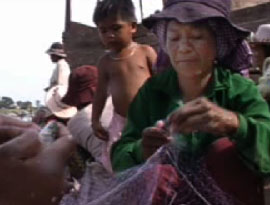14.4 MULTIPLE USES OF WATER AND THEIR IMPACTS
Changed
inundation patterns and implications for fishes
/ Salinization
and acidification
Pesticides and nutrient enrichment /
Irrigation,
parasites and human health
Water is needed to support the needs of both agriculture and wetlands
throughout the basin, from upper watersheds of tributaries to sea level
areas of the Mekong Delta. If water and land use decisions are made to
meet the needs of agriculture alone, then wetlands potentially will be
affected by water removal to supply irrigation needs, elimination or alteration
by drainage and conversion to agriculture, and changes in water quality.
If such decisions are made to meet the needs of wetlands alone, then improvements
to income and living conditions in agricultural areas may be constrained.
Loss/transformation of wetlands and consequences for
biodiversity--
Conversion of wetlands to agricultural land can result in the elimination
of the wetland ecosystem and species that depend upon it. Human activity
and noise that results from increased agricultural and other activity
in areas near wetlands can create disturbances that transform the wetland
so that the sensitive species no longer use it. Similarly, the wetland
ecosystem may be transformed by physical changes that result from alteration
to the wetland hydrology, and chemical changes that result from the presence
of pesticides, fertilizers, silt and other unwanted compounds. Loss or
transformation of the wetland will likely mean that the area is no longer
suitable for some species and they will cease to use it. The loss of species
will reduce biodiversity, and if some species are already exposed to greatly
reduced habitat and numbers, will contribute to species extinction on
a regional and possibly global scale.
Changed inundation patterns and
implications for fishes--
Fish use the annual inundation of floodplains along the Mekong River and
its tributaries for spawning and rearing, and have evolved to match critical
stages of their life history to the timing and magnitude of seasonal floods.
Actions that affect the annual hydrologic events, such as upstream irrigation,
hydroelectric or flood control works, could disrupt fish life stage events
causing reductions in abundance of some species.
Salinization and Acidification--
Salinity in parts of the Mekong River and its floodplain and tributaries
can be altered in several ways. Currently, saline water from the sea extends
tens of kilometers into delta areas of Vietnam, usually reaching maximum
penetration during the dry season when flow in the river is at its minimum.
A further reduction in flow resulting from upstream activity will likely
cause a corresponding increase in the extent of penetration of salt water
into the delta. Similarly, an alteration in the seasonal pattern of flow
likely will cause a change in the timing of saltwater intrusion into the
delta. Soils along the edge of the delta possess a gradation of salinities
with salinity being relatively high in some areas adjacent to the coast
with salinities becoming progressively lower at increasing distances from
the coast. These patterns also could change in relation to long-term changes
in the amount or timing of freshwater flow in the Mekong River.
Some soils, particularly in the delta area, have high levels of acidic
sulphate and, when disturbed, have potential to increase the acidity of
surrounding and downstream waters. Such a change in water conditions can
seriously affect species that are not able to tolerate relatively high
acidity. This problem often occurs in former or existing mangrove areas
when surface vegetation are removed for agriculture or aquaculture ponds.
Pesticides and nutrient enrichment--
Pesticides that are commonly used in agriculture to control insects and
other pests usually go beyond the place where they are intended for use
and enter receiving waters where they can cause ecological damage. This
can lead to serious damage if they enter small and fragile ecosystems
such as wetlands or come into contact with sensitive species that are
already few in number.
Nutrients can increase in river and wetland areas as a result of fertilizers
commonly used in agriculture and from other sources such as domestic waste.
Although nutrients are often not toxic, they can alter the ecological
status of rivers and wetlands through a process called nutrient enrichment.
This process may be beneficial for some species, but can be detrimental
for others. Nutrient enrichment can lead to high abundance of pollution-tolerant
plant and animal species, often leading to increased production of hardy
species of fish. However, it also often causes a reduction in species
diversity as more sensitive species avoid, or in some cases are killed
off, due to the nutrient enrichment. This can occur when high nutrient
concentrations cause reductions in oxygen levels.
Irrigation, parasites and human
health--
Irrigation works can create environments that are suitable for proliferation
of parasites, by creating seasonal water at locations and times it did
not previously occur. New water areas may provide habitat for disease-carrying
organisms (such as mosquitoes and snails) to complete their life cycle.
The consequence can be an increase in parasite-related diseases among
humans in the surrounding area.
|
|
